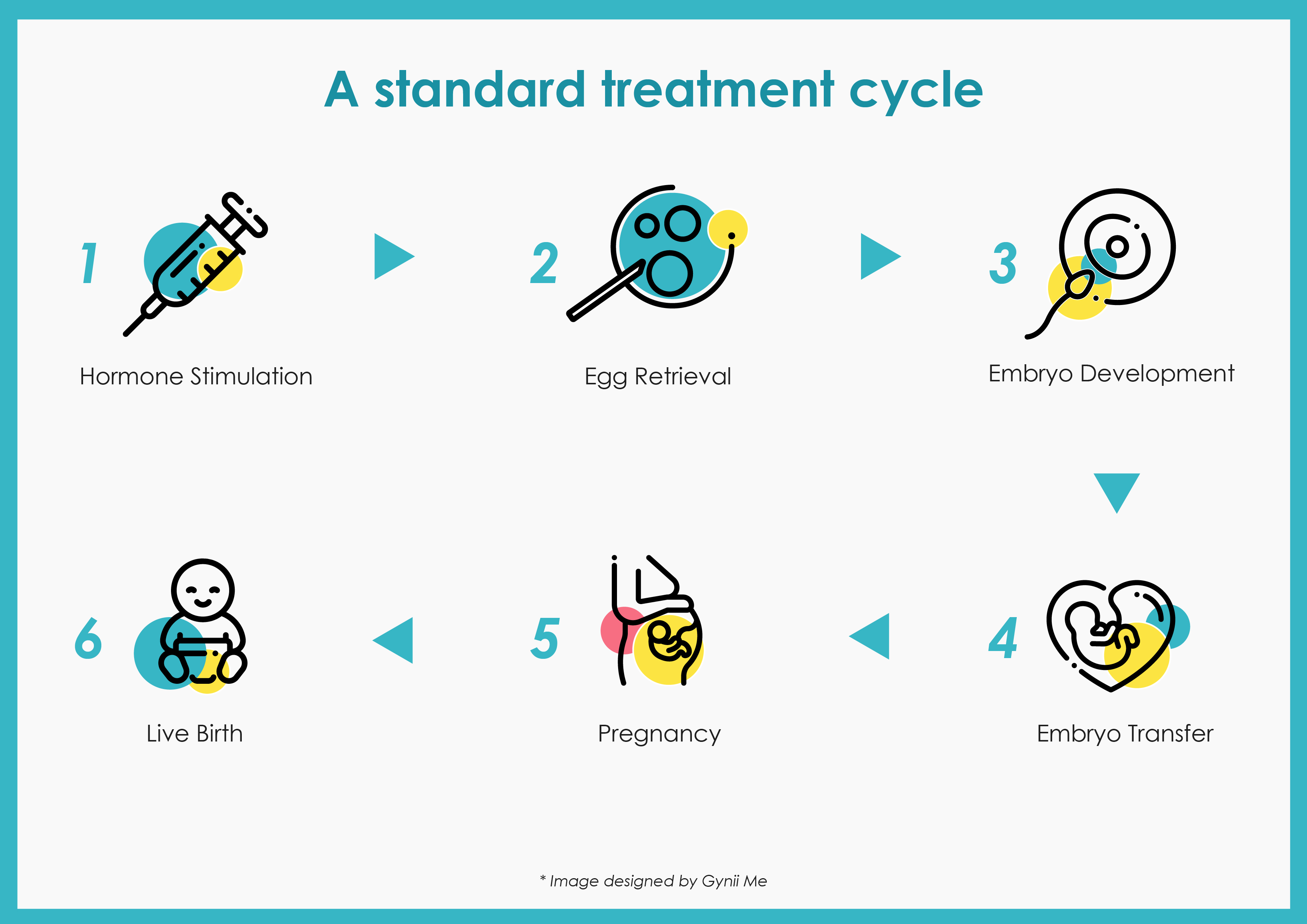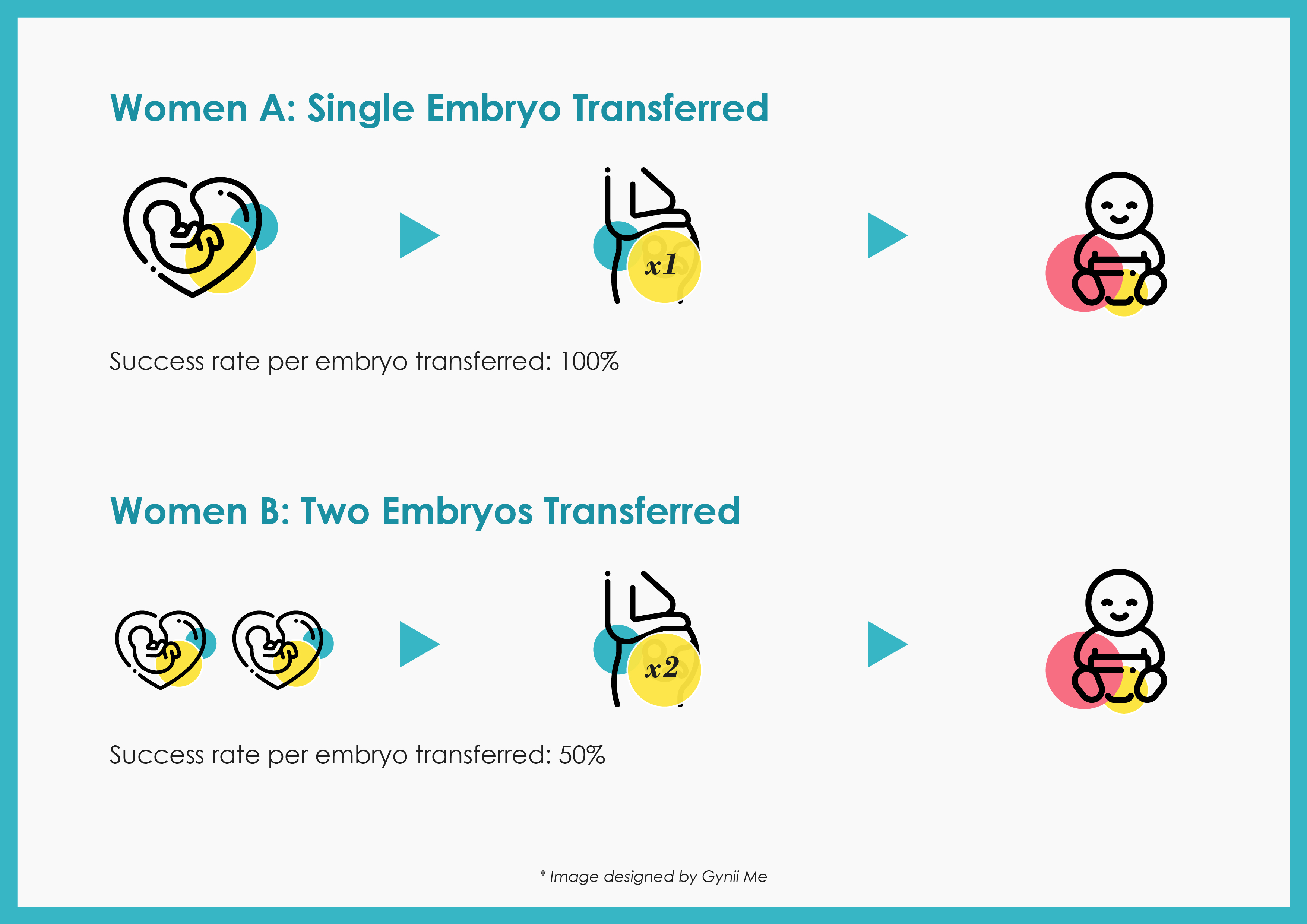Understanding fertility success rates
How is “success” defined?
Whether reported on Gynii Me’s, the HFEA’s, or another website or source, the reported success rates are usually based on a number of popular measures.
Each measure is designed to give you an overall idea of the success of the treatment for a clinic; it is not easy to say which is the most reliable or best measure.
To help you work out what it all means, we have included a brief guide to terms (or expressions) used when describing fertility treatment success rates.
Treatment cycle
A “treatment cycle” refers to the process of beginning and ending (or completion) of a fertility treatment for a patient. For example, a single cycle of IVF would include hormone stimulation through to the embryo transfer.
This figure shows each of the stages in a standard treatment cycle; starting with hormone stimulation, through to a live birth. Most of these stages are monitored by fertility clinics, to help them base their success rates on.

Treatment cycle - 1. Hormone stimulation
Hormone stimulation is the start of the treatment cycle. It usually comes after initial consultation and supporting tests, such as blood tests and ultrasound examination.
Fertility medication, given to the patient, stimulates the ovaries so that they develop a number of eggs. The medication is chosen specifically for each patient to give them the best chance of success, based on their medical history.
When a success rate measure refers to “… per treatment cycle”, for example, “live births per treatment cycle*”, it means treatment which starts at this (the earliest) stage of the overall treatment cycle.
*You may also see success rates referring to: “… per treatment cycle commenced” or, “… per treatment cycle started”.
Treatment cycle - 2. Egg retrieval
Egg retrieval or egg collection involves the collection of eggs.
Not all egg retrieval procedures are preceded by hormone stimulation. Sometimes eggs are retrieved following a natural ovulation cycle (one which has not involved fertility medication).
Treatment cycle - 3. Embryo development
Sperm is introduced to the eggs; embryo development occurs if this process is successful.
More than one embryo may develop at this stage. When there is more than one embryo suitable for transfer, the options include:
- All, but one, may be frozen for later use;
- For good clinical reasons, two embryos may be transferred, the rest frozen;
- Sometimes all embryos are frozen and subsequently introduced into the uterus one-by-one. Many clinics are now achieving higher success rates by transferring frozen embryos, as it allows the patient’s body to fully recover from the hormonal stimulation process.
The embryo transfer option followed will be determined by your fertility expert, based on your personal circumstances.
Treatment cycle - 4. Embryo transfer
One – or sometimes more than one – embryo is transferred into the uterus (or womb), so it may implant and develop into a baby.
Note that, many fertility clinics have presented success rates in terms of the number of embryo transfer procedures. For example,
Woman A has a single embryo transferred to her in a single embryo transfer procedure and goes on to give birth to a single baby.
Woman B has 2 embryos transferred to her in a single embryo transfer procedure and goes on to give birth to a single baby.

A fertility clinic will present the success rate for both Woman A and Woman B as 100%, i.e. both women had one embryo transfer procedure and both women went on to have a single baby.
The HFEA (the UK’s fertility regulator) now asks fertility clinics for the success rates “…per embryo transferred”. So in our example, the success rates for Woman A remains the same, i.e:
Women A has a single embryo transferred to her in a single embryo transfer procedure and goes on to give birth to a single baby. The success rate is 100%
For Woman B, however:
Woman B has 2 embryos transferred to her in a single embryo transfer procedure and goes on to give birth to a single baby. So, the success rate per embryo transferred is 50% (the number of births divided by the number of embryos transferred).
Both methods of calculating the success rate are correct, but it’s important to be clear how the success rate for embryo transfer is being calculated.
Gynii Me supports the HFEA’s recommendation, that transferring one embryo at a time, is often the safest option of securing a live birth. However, a patient’s individual requirements may mean that there are obvious medical benefits to transferring two embryos at the same time. For example, a patient who is over 40, with fewer opportunities for further IVF cycles, may have two embryos transferred in a single treatment procedure.
Treatment cycle - 5. Pregnancy
There are several ways pregnancy can be described by fertility clinics. The most definitive is what is known as a “clinical pregnancy”, or “positive clinical pregnancy”. This is a pregnancy confirmed using an ultrasound test around 6 – 7 weeks into the pregnancy; when the baby’s heartbeat is detected in a scan.
Some clinics refer to success results in terms of “biochemical pregnancy”, or “chemical pregnancy”. This is early detection of the pregnancy using a pregnancy test, similar to the ones supplied over-the-counter by high-street chemists to be used at home.
Sadly, one in five pregnancies ends in miscarriage, the vast majority of these miscarriages occurring before 6 weeks. So when you are comparing clinics' success rates it is important to compare “like-for-like”. Some clinics will be talking about the success in terms of the number of women who achieved a positive pregnancy test, whereas other clinics will base their results on the detection of a heartbeat at 6 weeks, and others will be talking about the number of resulting live births following fertility treatment.
A limitation of the pregnancy success rates measurement – whether a chemical or clinical pregnancy - is that the figures reported will also include women who may later miscarry.
Treatment cycle - 6. Live birth
The number of live births is a logical measure to use to gauge a clinic’s success, as this is the result patients undergoing IVF are seeking.
Although the number of live births reflects the most satisfactory outcome, it is not always the measure used when reporting success rates. This is because following up and recording the live births which have occurred is often quite a slow process. Perhaps for this reason, “pregnancy” is frequently used to report success rates.
It may seem odd, but multiple births, such as twins, triplets, or more, babies, are also counted as a single live birth.
Continue to read Making sense of success rates
If you have any questions on fertility success rates, please email us at hello@gyniime.com
About Gynii Me
Gynii Me is a UK based company dedicated to supporting individuals and couples throughout their fertility journey.
We are committed to helping you, no matter what your situation or background, to understand your options and make the right decisions at each stage of your journey in starting a family.
Our ultimate goal is to make fertility treatments accessible, affordable and transparent.
Our services
Gynii Me provides the following services:
- Helping you choose the right fertility clinic and specialist doctor based on your age, health information and location
- Access to our experience and specialist knowledge to help guide your fertility journey
- Support to ensure a stress-free experience throughout your fertility treatment
- Health management, including emotional support and wellness management, before and during fertility treatment
- Providing flexible treatment funding options.
Gynii Me’s services can be accessed via our easy-to-use website, or please get in touch with us at hello@gyniime.com.

Connect with us